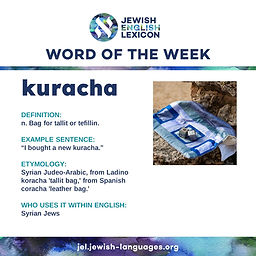

Like candlesticks, jewelry, and other physical heirlooms, heritage words connect us to our ancestors and keep their memories alive. On this page, learn how to identify heritage words, record and share them, and pass them on to the next generation.

Heritage words come from languages once spoken by our ancestors, especially in immigrant or indigenous groups. After a family shifts to a dominant language, individual words and phrases from the ancestral language are passed down through family or community and used within the new language, especially in in-group conversations.
Common categories of heritage words, with examples from Jewish English:
-
foods (Juhuri: qoqol, Yiddish: cholent, Judeo-Arabic: adafina, Bukharian: bakhsh)
-
endearment (Persian: joon, Judeo-Arabic/Modern Hebrew: kapara, Jewish Neo-Aramaic: qorbanokh)
-
culture and religion (Bukharian: kenisa, Judeo-Arabic: kuracha, Yiddish: pushke)
-
expressions (Persian: chetori, Yiddish: a yor mit a mitvokh, Ladino: bivas kreskas enfloreskas)

DICTIONARIES

The Jewish Language Project maintains several crowdsourced dictionaries of heritage words in contemporary Jewish languages:
-
English: Jewish English Lexicon
-
Portuguese: Léxico Judaico-Brasileiro
-
German: Judäo-Deutschen Wörterbuch
-
French: Glossaire du francais juif
-
Spanish: Léxico Judío-Latinoamericano
-
Swedish: Lexicon Över Judisk Svenska
-
Greek: Εβραιοελληνικό Λεξικό
-
Dutch: Joods Nederlands Lexicon
We invite visitors to add entries or recordings or suggest edits to existing entries:
-
Select the appropriate dictionary above.
- Search the dictionary to see if your word is already listed.
-
If your word is not listed, add it, including recordings of the word and example sentence.
-
All entries and edits are moderated and may take a few weeks to show up on the site.
-
If your language is not listed or you have questions, submit this form so we can assist you.
Follow us on social media, where we post "Jewish word of the week," along with fun facts and Jewish language news. See our archive of Jewish word posts.



HERITAGE WORDS PODCAST

Engaging interviews about the words we inherit
and the meaning they bring to our lives
We explore the significance of these words in our Heritage Words podcast, available on Spotify, Apple, and anywhere you get your podcasts. Episodes are posted every other week, and videos of each episode are posted on our YouTube channel. Some examples of heritage words discussed in the interviews:
-
Telahun Liad Samuel shares his experiences doing hamotzi (the blessing over bread) with dabo, an Amharic word for a traditional Ethiopian Shabbat bread.
-
Sarah Aroeste speaks – and sings – about masadiku, an empanada-like savory pastry filled with potato and cheese, a recipe passed down by her Ladino-speaking ancestors from Monastir.
-
Rozeeta Mavashev reports that her mother uses the Bukharian word jonam (darling), similar to the Persian word joon, as in “How are you doing, jonam?”
-
Sam Miller has fond memories of his Jewish Neo-Aramaic-speaking grandmother expressing love with qorbanokh (dear one, lit. “your sacrifice”), similar to the Judeo-Arabic and Modern Hebrew word kapara.
-
Anthropologist Evelyn Dean-Olmsted, who coined the term “heritage words,” says the word pishar (to urinate) is common in the Spanish of Mexican Jews, likely an influence from Ladino or Yiddish but also claimed by Syrian Jews as Judeo-Arabic.
-
Mayim Bialik (yes, THAT Mayim Bialik) uses diminutive forms of Yiddish words for body parts when speaking to her children, like hentlekh (hands) and eygies (eyes).
Many of the podcast guests associate these heritage words with particular ancestors: parents, grandparents, even great-grandparents. Using the words and speaking about them may bring up strong emotion and offer a way to connect to their ancestors love after they are gone.
The podcast also explores other aspects of language, like activists working to record or revitalize an endangered language, musicians performing in multiple languages, and converts to Judaism learning Jewish English. If you have ideas for guests or topics for future episodes, please get in touch.




ENGAGEMENT IDEAS

Engage with heritage words in your home, synagogue, school, or other community.
Sharing heritage words
At any social gathering, including on Shabbat, Sukkot, or Passover, ask attendees to share a heritage word. Whether discussed in group conversation or written on name tags, this serves as a unique ice breaker. Sample instructions: "Share a word you inherited from your family that isn't common in English more broadly, especially from an ancestral language that you heard or used in your family after your family stopped speaking the language; examples: terms of endearment (motek), foods (gondi), kinship terms (nona), body (keppie), or anything else (sechel)." For details, see JLP Director Sarah Bunin Benor's article about sharing heritage words in the sukkah.


Storytelling
Organize a listening club around the Heritage Words podcast. Discuss one or more episodes at each gathering. Then host a storytelling event where participants tell stories about their own connections to languages and names. Or create a booklet or website compiling such stories from many community members.
Word of the week
Follow the Jewish Language Project on Facebook, Instagram, Threads, TikTok, and/or YouTube, and share current Fun Fact and Word of the Week posts in newsletters or on social media. You can also share past posts from the Fun Fact and Word of the Week archives.
Exhibit
Mount a free downloadable exhibit about Jewish languages produced by the Jewish Language Project and ANU: Museum of the Jewish People. Through images, text, and multimedia QR codes, the 31-panel exhibit highlights the development of Jewish languages, holiday resources, language preservation efforts, and heritage words.
Posters
Decorate your home, synagogue, school, community center, or sukkah with posters highlighting individual heritage words or multilingual graphics.
Mapping
Post a world map and have community members post sticker dots on the locations where their ancestors lived. You can also create an interactive digital map, including ancestors' names, birth dates, migrations, and heritage words, with our Ancestry Mapping Service.









